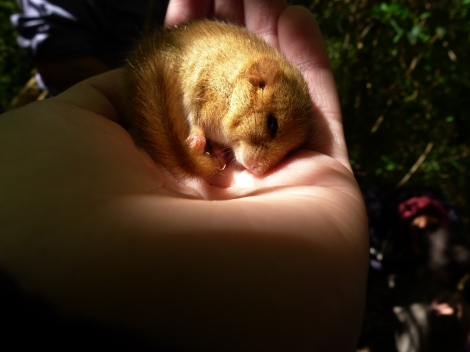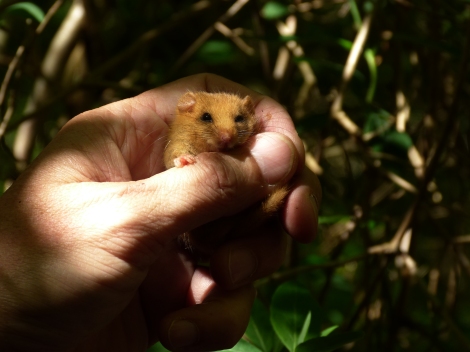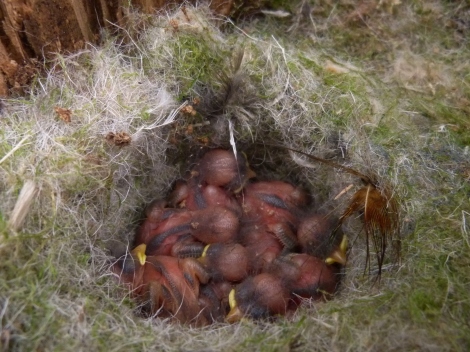UK Animal Profile – The Dormouse who fell asleep instantly
Before writing this blog post, I did a quick whip-round knowledge survey of my friends and family via Facebook and e-mails on their knowledge of the hazel dormouse. Roughly one fifth had never heard of them, whilst almost two thirds knew of them but knew nothing about them. Only 3 people out of 28 knew a few facts. Obviously this is only a quick and unprofessional survey of my own contacts, but I wonder how much it reflects the UK as a whole? Furthermore, I wonder how much the knowledge of dormouse varies between counties where they are found and counties where they are not.
Anyway, this is an overall view of the hazel (common) dormouse, with the facts that I find particularly interesting. I hope that you will enjoy and come to love this species as many do.
The common or hazel dormouse is a distinctive species, easily recognizable when compared to our other small mammals here in Britain. With prominent black eyes, rounded ears and soft golden fur, you can’t help but think of the word “cute”. Add in that fact that they have a furry tail, rather than the hairless one of mice or rats that often freaks out people, and they become even more adorable.
(Perhaps it is wrong of me to use these subjective terms, but I know that this is how many people feel. For myself, I will describe many animals as cute, lovely or beautiful, much to the befuddlement of my friends. Crikey, I’ve even called a cockroach cute! But I digress.)
Their large black eyes and other adaptations are indicators of their behaviours. Such eyes help to them to see in the dark as they are nocturnal animals, whilst their feet have small pads, sharp claws and hind ankles can turn sideways, all adaptations for arboreal living (in the trees). Their daytime activity consists of sleeping in a nest, sometimes in torpor where an animal’s metabolic rate and body temperature is low, to reduce the energy used by its body. During torpor, an animal does not respond to stimuli. Torpor is quite similar to hibernation, though hibernation lasts for much longer whereas torpor lasts for only a few hours at a time.
Now if you’re like me, you may have had a similar thought upon reading the previous paragraph. Nocturnal, sleeping in the day, not responding to stimuli … is it only me that thinks of students? Particularly prior to assignment deadlines!
The sleeping activity of dormice doesn’t stop there, they also hibernate. This starts in October or November, lasting through to March or April, during a time when there are no food supplies. Rather than hibernating up in a tree, they actually hibernate in a nest at, or below, ground level. This means that it is easier for them to maintain a consistent temperature and not become dehydrated.
If you combine the time spent asleep by the dormouse – sleeping, torpor and hibernation, you realise that this species actually spends much of its time asleep. As Pat Morris (a leading expert of many British mammal species) says in one article: “It’s almost as though their natural state is asleep”. Again … anyone else thinking of students here? This is perhaps one of the best-known traits of dormice, mentioned in literature such as Alice’s Adventures In Wonderland (Lewis Carroll) – ““The Dormouse is asleep again” said the Hatter” (hopefully you noticed that is where part of this post’s title is from).
Dormice are well known for eating hazel nuts, but they will also eat a variety of other foods including flowers (from bramble, rowan, oak and honeysuckle) and invertebrates (aphids and caterpillars). During late summer and autumn, dormice need to gain fat reserves for their hibernation for which hazel nuts are a good source. Dormice eat hazel nuts in a distinctive way, leaving a hole with a smooth inner edge and toothmarks around the hole. This means that eaten nuts can be used to find out if dormice are present in an area, and Great Nut Hunts have been run by PTES (Peoples’ Trust for Endangered Species) where the public searched for nibbled nuts to find new sites where dormice were present.
Some other interesting facts
- A female dormouse may actually mate with multiple males, producing a litter sired by a variety of fathers. However, the benefit to the female is not yet clear. For the species as a whole, it is likely due to greater genetic variation and to counter inbreeding.
- The dormouse is a priority and fully legally protected species in the UK and in Europe, and a license is needed to work with them. (I currently don’t have a license, my encounters with them have been through volunteering or on educational, and always with a license holder.)
- Typically the dormouse has been associated with old deciduous woodland, hazel coppice and hedgerows. However, they have been found in conifer woodland, gorse, scrub, heath and reed beds.
- The other species of dormouse in the UK is the edible dormouse, Glis glis, which was introduced deliberately into Tring in the early 20th C.
Now I know that I’ve not covered everything about the dormice, such as the threats they face or more detailed analysis of their behaviours, as this is just a general overview and introduction to this species. If you are interested, both the Mammal Society and PTES have plenty of information of them (as well as other species), as will other organisations.
“… the last she saw of them, they were trying to put the Dormouse into the teapot.”
– from Alice’s Adventures In Wonderland by Lewis Carroll.
NB: I should point out that my remarks about people not knowing much about dormice isn’t a slur against my friends and family for not knowing, just something I found interesting. Particularly since mammals are the animal group that people usually identify best with, yet the overall knowledge of even this group can be rather low. One of the reasons I enjoy doing small mammal trapping with children, it’s a chance to create some memories of wildlife that can stay with them for life. But the topic of children and wildlife is a whole other kettle of fish (or a nest of mammals?).
References
Ambrose, M. et al (2012), Wilder Wych Dormouse Research Project, A study of the re-introduced dormouse population in the Wych Valley, Cheshire.
ARKive, Common dormouse (Muscardinus avellanarius), http://www.arkive.org/common-dormouse/muscardinus-avellanarius/ [Accessed: November 2013]
Bright, P. and Morris, P. (1991). Ranging and nesting behaviour of the dormouse Muscardinus avellanarius in diverse low-growing woodland. Journal of Zoology, London, 224: 177-190.
Bright, P.W., Morris, P.A. and Mitchell, J.T. (2006), The dormouse conservation handbook, English Nature, Great Britain.
Mammal Society, Dormouse FactSheet: http://www.mammal.org.uk/species-factsheets/Dormouse
Md. Naim, D. et al (2011), Prevalence of multiple mating by female common dormice, Muscardinus avellanarius, Conservation Genetics, 12, 971-979.
Morris, P. (2004), Dormice, M. Avellarnarius, Whittet Books, Stowmarket, UK.
Morris, P. (2012), Taking a closer look at the dormice in torpor, The Dormouse Monitor, (1), 7.
People’s Trust for Endangered Species (2011), The Golden Great Nut Hunt report: http://www.ptes.org/files/1640_gnhreportnov2011.pdf



